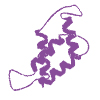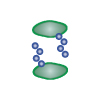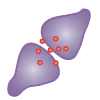Neurodegenerative diseases result from the loss of neurons in the nervous system, which can have debilitating effects like dementia, memory loss, and ataxia. Treatment for these diseases are limited, raising the need to gain a better understanding of their mechanisms and origins. Utilize reliable protein- and modification-specific antibodies, recombinant proteins, assay kits, and reagents to study protein aggregation and cellular processes involved in neurodegeneration.
Neurodegeneration
 Amyloid-β – Amyloid precursor protein (APP) is cleaved by enzymes like secretase into various species of amyloid-β (Aβ) peptides, which may have physiological roles in infection defense, blood-brain barrier repair, and brain injury recovery. Under healthy conditions, Aβ is quickly cleared from extracellular space and the cerebrospinal fluid, but genetic and environmental factors can cause the aberrant accumulation of Aβ. This leads to Aβ aggregation and the formation of higher-order structures (oligomers, fibrils, and plaques) that are associated with Alzheimer’s disease.
Amyloid-β – Amyloid precursor protein (APP) is cleaved by enzymes like secretase into various species of amyloid-β (Aβ) peptides, which may have physiological roles in infection defense, blood-brain barrier repair, and brain injury recovery. Under healthy conditions, Aβ is quickly cleared from extracellular space and the cerebrospinal fluid, but genetic and environmental factors can cause the aberrant accumulation of Aβ. This leads to Aβ aggregation and the formation of higher-order structures (oligomers, fibrils, and plaques) that are associated with Alzheimer’s disease.
Browse products for Amyloid-β.
 Tau – Microtubules are critical for the transport of cellular cargo through axons, and are therefore in a constant state of polymerization and depolymerization. Stabilizing proteins like Tau help assemble and regulate microtubules in neurons and glial cells. Misfolded and hyperphosphorylated Tau proteins, however, will form self-propagating aggregates called neurofibrillary tangles (NFTs) which are unable to perform their normal role in microtubule stabilization. This results in loss of neuronal function, and can lead to neurodegenerative diseases like frontotemporal dementia (FTD), Pick’s disease, and Alzheimer’s disease.
Tau – Microtubules are critical for the transport of cellular cargo through axons, and are therefore in a constant state of polymerization and depolymerization. Stabilizing proteins like Tau help assemble and regulate microtubules in neurons and glial cells. Misfolded and hyperphosphorylated Tau proteins, however, will form self-propagating aggregates called neurofibrillary tangles (NFTs) which are unable to perform their normal role in microtubule stabilization. This results in loss of neuronal function, and can lead to neurodegenerative diseases like frontotemporal dementia (FTD), Pick’s disease, and Alzheimer’s disease.
Browse products for Tau.
 α-Synuclein – α-Synuclein is a protein that is primarily found in the central nervous system (CNS), but is expressed at low levels in a variety of other tissues. It is predominantly localized to presynaptic terminals of neurons and plays a role in regulating membrane vesicle trafficking. Mutations and modifications of α-Synuclein can lead to its aggregation and the formation of Lewy bodies, which can cause Parkinson’s disease, multiple system atrophy, and Lewy body dementia.
α-Synuclein – α-Synuclein is a protein that is primarily found in the central nervous system (CNS), but is expressed at low levels in a variety of other tissues. It is predominantly localized to presynaptic terminals of neurons and plays a role in regulating membrane vesicle trafficking. Mutations and modifications of α-Synuclein can lead to its aggregation and the formation of Lewy bodies, which can cause Parkinson’s disease, multiple system atrophy, and Lewy body dementia.
Browse products for α-Synuclein.
 Prion – Cellular prion protein (PrPC) is expressed on the surface of cells in different tissues, with the highest expression in the nervous system. In neurons, it is localized to pre- and postsynaptic structures, suggesting a role for PrPC in regulating synaptic function. The pathogenic and misfolded form of the prion protein, PrPSc, can spontaneously arise or be transmitted, and will catalyze the transformation of PrPC into PrPSc. This leads to PrPSc aggregation and development of neurodegenerative diseases like Creutzfeldt-Jakob disease (CJD), Kuru, and scrapie.
Prion – Cellular prion protein (PrPC) is expressed on the surface of cells in different tissues, with the highest expression in the nervous system. In neurons, it is localized to pre- and postsynaptic structures, suggesting a role for PrPC in regulating synaptic function. The pathogenic and misfolded form of the prion protein, PrPSc, can spontaneously arise or be transmitted, and will catalyze the transformation of PrPC into PrPSc. This leads to PrPSc aggregation and development of neurodegenerative diseases like Creutzfeldt-Jakob disease (CJD), Kuru, and scrapie.
Browse products for Prions.
 Ubiquitination – Ubiquitin is a small regulatory protein that is attached to other proteins to control processes like degradation and endocytic trafficking. Ubiquitin accumulates in morphologically distinct proteinaceous deposits associated with neurodegeneration, and can therefore be used as a marker for disease.
Ubiquitination – Ubiquitin is a small regulatory protein that is attached to other proteins to control processes like degradation and endocytic trafficking. Ubiquitin accumulates in morphologically distinct proteinaceous deposits associated with neurodegeneration, and can therefore be used as a marker for disease.
Browse products for ubiquitination.
 Autophagy – Autophagy is a process that degrades and removes dysfunctional proteins and damaged organelles by delivering cytoplasmic material to the lysosome. Since autophagy is responsible for clearing pathogenic protein aggregates, defects in autophagy pathways have been linked to neurodegenerative diseases.
Autophagy – Autophagy is a process that degrades and removes dysfunctional proteins and damaged organelles by delivering cytoplasmic material to the lysosome. Since autophagy is responsible for clearing pathogenic protein aggregates, defects in autophagy pathways have been linked to neurodegenerative diseases.
Browse products for autophagy.
 Synaptic function – Synapses are the junctions between neurons, and are the sites of neurotransmitter release and reception. Loss of synaptic function and connections during neurodegenerative diseases causes a breakdown of the nervous system and its ability to operate properly.
Synaptic function – Synapses are the junctions between neurons, and are the sites of neurotransmitter release and reception. Loss of synaptic function and connections during neurodegenerative diseases causes a breakdown of the nervous system and its ability to operate properly.
Browse products for synaptic function.
Other Proteins Involved in Neurodegeneration
| LRRK2 | LRRK2 is a kinase that interacts with Parkin at the mitochondrial membrane to regulate mitophagy. Mutations in LRRK2 are associated with late-onset Parkinson’s disease. |
| LC3 | LC3 is a microtubule-associated protein that interacts with autophagosome membranes to facilitate the engulfment of cytoplasmic contents. |
| SOD1 | Superoxide dismutase (SOD1) protects cells from reactive oxygen species. Mutations in SOD1 have been associated with diseases like amyotrophic lateral sclerosis (ALS). |
| TDP-43 | TAR DNA binding protein 43 kDa (TDP-43) is a transcriptional regulator, and its aberrant ubiquitination and phosphorylation is associated with ALS and FTD. |
| FUS | FUS is an RNA-binding protein that is normally found in the nucleus. In diseases like ALS, FUS morphology is altered and associates with cytoplasmic inclusions. |
| TG | Transglutaminases (TGs) help form polypeptide linkages in neurons and astrocytes. Abnormal increases in TG activity are associated with Huntington’s and Alzheimer’s diseases, among others. |
| Apo-E | Apolipoprotein E (Apo-E) has many physiological roles, including lipid metabolism and Aβ removal. Loss of these functions, as well as a gain of toxic functions, can lead to neurodegenerative disease. |
| Dynactin | Dynactin regulates dynein activity and the transport of cytoplasmic cargo along microtubules. Mutations in dynactin have been associated with motor neuron diseases. |
| Clusterin | Clusterin (apolipoprotein J) is a chaperone protein involved in the regulation of inflammation. Clusterin levels are increased in the cerebrospinal fluid of patients with Alzheimer’s disease. |
 Login/Register
Login/Register 






Follow Us